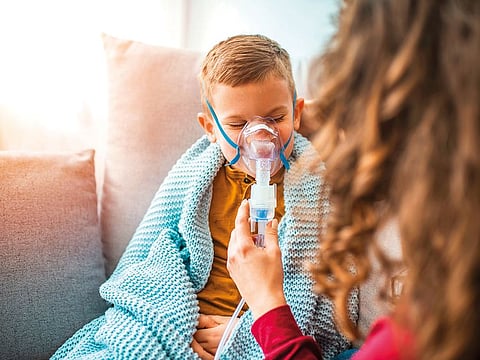World Asthma Day: 5 steps to monitor asthma in children
Raising awareness among parents on risks of asthma in children

Asthma is a long-term lung disease that causes swelling and narrowing of the lung tubes. It is as a result of the interplay between genes and environmental factors like allergies and viral infections. Since childhood asthma is on the rise all over the world and in the UAE, it is important for parents to be armed with the necessary information.
1. Get to know your child’s asthma meds
For this clear communication is essential with the pediatrician as to what type of asthma your child has (mild, moderate or severe), the usual triggers of an attack and how these medicines help your children and how to use them in different situations that trigger an asthmatic attack. If you know how they work, you will be more likely to make sure to take them as prescribed. Children are usually prescribed a preventer inhaler (or any other preventer medicine) and a reliever inhaler for when they get symptoms.
Asthma doesn't have to stop your child from being active. On the contrary exercise is actually good for asthma, if their asthma is well managed. Regular exercise improves how well the child’s lungs work, and boosts the child’s immune system.

2. A written asthma action plan
A good written plan formulated with the help of your healthcare provider on how to manage symptoms and handle emergencies empowers the family to do the right things. It is important for parents and older children to recognise the warning signs of an asthma attack, after discussion with their pediatrician. A copy of the plan can also be given to the school health nurse and one kept handy at a prominent location at home — taped to the fridge, perhaps. A good plan helps the parent and child transition easily from a crisis mode to control mode.
3. Be aware of usual triggers
Asthma attacks can usually be precipitated by a viral infection like a cold, dust, or even stressful times like exams. In summer in the UAE, and now with the pandemic, children spend most of the time indoors within an air-conditioned environment, without commendable ventilation. This can increase dust mite triggers. Proper cleaning of the air-conditioner vent and filter, regular vacuuming, especially of the bedding and drapes, using an allergen proof bed cover, all help. Keep humidity low, and installing a high-efficiency media filter in the air-conditiner can help. An annual flu shot is critical.
4. Exercise
Asthma doesnt have to stop your child from being active. On the contrary exercise is actually good for asthma , if their asthma is well managed. Regular exercise improves how well the child’s lungs work, and boosts the child’s immune system. Exercise also keeps your childs weight under control. Overweight children are more likely to get more asthma symptoms.
5. Be patient with long-term treatments
Preventer medicines do not immediately relieve symptoms but will definitely help if used consistently over the long term. So it is important to have realistic expectations about the duration of treatment after discussion with the pediatrician. Besides, review visits can be utilised to discuss consistent flare ups, despite proper use of medicines, thereby reevaluating treatment protocol.
- The writer is Specialist Pediatrician, Aster Clinic, Sheikh Zayed Road
Sign up for the Daily Briefing
Get the latest news and updates straight to your inbox


